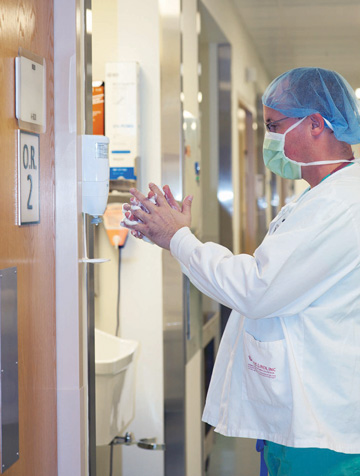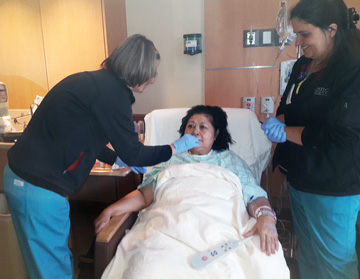• Pre-op skin prep. Several years ago, UC San Diego (UCSD) Health formed a multidisciplinary team to assess the hospital’s SSI practices surrounding colorectal surgery, says Nick Hilbert, MSN, RN, clinical quality improvement
specialist at UCSD Medical Center. As part of the initiative, the facility put into place a refined bundle of care, which eventually reduced the health system’s colorectal surgery SSI rate from 21.8% in 2015 to 8.6% in 2019.
Pre-op bathing with chlorhexidine gluconate (CHG) was already an element of the bundle of care, but it was reinforced through the process improvement project. Patients are expected to shower with CHG soap a minimum of three times before their
procedures: the morning on the day before surgery, the night before surgery and the morning of the day of surgery. Patients are given step-by-step instructions on how to apply the CHG, with specific notes to avoid using perfumes and lotions,
and to put on clean clothes and sleep on freshly laundered sheets afterward.
“To make the process clear to patients and to reinforce its importance, the instructions are given at the surgeon’s office visit before surgery and later reviewed at the pre-anesthesia visit,” says Mr. Hilbert. Additionally,
on the day of surgery the care team carries out “nose-to-toes” antisepsis, which includes a combination of nasal prepping with povidone-iodine, oral cleansing with CHG and skin prepping with 2% CHG wipes.
• Nasal decolonization. Ms. Groven suggests tailoring pre-op care instructions based on the surgeries patients are scheduled to undergo. For example, patients who are preparing for total and partial joint replacements at TRIA Orthopedic
Center are screened for Methicillin-resistant Staphylococcus aureus (MRSA) two to four weeks before their surgeries. Patients who test positive, in addition to undergoing nasal decolonization with the topical antibiotic mupirocin, are
instructed to wash their skin with CHG soap starting five days before surgery and use CHG wipes the day before surgery. Patients who do not test positive for MRSA use CHG wipes the night before and morning of surgery.
Staff and surgeons at some surgery centers might not have the resources or interest to screen every patient for MRSA and treat carriers with a course of mupirocin, which adds to the cost of care and increases concerns about antimicrobial resistance.
They can instead opt for a more economic and effective option by decolonizing the nares of all patients with povidone-iodine or an alcohol-based antiseptic in pre-op on the day of surgery.
• Hand hygiene. To help enforce hand hygiene compliance, TRIA Orthopedic Center’s leadership conducts random audits of the frontline staff’s performance and tracks the results over time. These numbers are shared at staff
meetings, daily huddles and on the break room bulletin board. Additionally, flyers and posters with lighthearted reminders about practicing hand hygiene are placed around the facility. The content on the flyers and posters are changed frequently
to keep staff engaged.
The facility also addresses barriers that prevent good hand hygiene. “Provide staff with access to the right antiseptic products, so they don’t feel deterred to apply them by issues such as dry hands or rashes,” says Ms. Groven.
“Make sure the lotions placed around the facility are safe for staff to use — and stress the importance of them not bringing in their own products from home.”
• Surface cleaning. OR turnovers and overnight terminal cleans are key aspects of infection prevention protocols, points out Ms. Groven, who says TRIA’s staff work with housekeeping to regularly check the effectiveness of room
cleanings. This is done with random inspections, during which clinical leadership uses a blacklight marker to mark a specific surface in an OR prior to the terminal cleaning, and then check the mark again afterward to ensure it was scrubbed
off.
“For example, management might mark the side of a bed,” says Ms. Groven. “After the room is cleaned, the manager goes back later that night or early the next morning and checks with a black light to see if the mark is still there.”
The results of these random checks are discussed during monthly meetings with housekeeping.
TRIA’s clinical leaders receive regular reports of the random blacklight audits and use a red-yellow-green scoring system to compare monthly results. “We’re given mapping reports that include quarterly outcomes,” explains
Ms. Groven. “Green means the results were better than the previous month, yellow indicates they remained the same and red means they were worse.”
The leadership team also conducts regular rounds with members of the housekeeping staff to ensure they know how to best clean OR surfaces and are up to speed on the facility’s current cleaning policies.
To make housekeeping’s job easier, members of the cleaning staff are given a checklist of tasks to complete in each OR, as well as photos of the proper placement of equipment in the room to make sure they know how it needs to be set up.
The center’s leadership receives daily emails from housekeeping supervisors listing what was done to ensure their team followed the facility’s cleaning policies.
.svg?sfvrsn=be606e78_3)


.svg?sfvrsn=56b2f850_5)